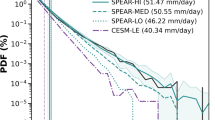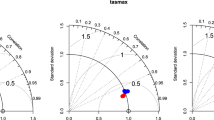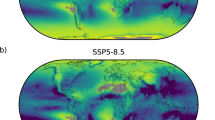Abstract
Global temperatures have risen over the past few decades. The water vapour content of the atmosphere has increased as a result, strengthening the global hydrological cycle1,2,3,4. This, in turn, has led to wet regions getting wetter, and dry regions drier1,2,3,4,5,6. Climate model simulations suggest that a similar intensification of existing patterns may also apply to the seasonal cycle of rainfall7. Here, we analyse regional and global trends in seasonal precipitation extremes over the past three decades, using a number of global and land-alone observational data sets. We show that globally the annual range of precipitation has increased, largely because wet seasons have become wetter. Although the magnitude of the shift is uncertain, largely owing to limitations inherent in the data sets used, the sign of the tendency is robust. On a regional scale, the tendency for wet seasons to get wetter occurs over climatologically rainier regions. Similarly, the tendency for dry season to get drier is seen in drier regions. Even if the total amount of annual rainfall does not change significantly, the enhancement in the seasonal precipitation cycle could have marked consequences for the frequency of droughts and floods.
This is a preview of subscription content, access via your institution
Access options
Subscribe to this journal
Receive 12 print issues and online access
$259.00 per year
only $21.58 per issue
Buy this article
- Purchase on Springer Link
- Instant access to full article PDF
Prices may be subject to local taxes which are calculated during checkout



Similar content being viewed by others
References
Knutson, T. R. & Manabe, S. Time-mean response over the tropical Pacific to increased CO2 in a coupled ocean–atmosphere model. J. Clim. 8, 2181–2199 (1995).
Held, I. M. & Soden, B. J. Robust responses of the hydrological cycle to global warming. J. Clim. 19, 5686–5699 (2006).
Wentz, F. J., Ricciardulli, L., Hilburn, K. & Mears, C. How much more rain will global warming bring? Science 317, 233–235 (2007).
Allan, R. P., Soden, B. J., John, V. O., Ingram, W. & Good, P. Current changes in tropical precipitation. Environ. Res. Lett. 5, 025205 (2010).
John, V. O., Allan, R. P. & Soden, B. J. How robust are observed and simulated precipitation responses to tropical ocean warming? Geophys. Res. Lett. 36, L14702 (2009).
Li, L. et al. Recycling rate of atmospheric moisture over the past two decades (1988–2009). Environ. Res. Lett. 6, 034018 (2011).
Chou, C. & Lan, C-W. Changes in the annual range of precipitation under global warming. J. Clim. 25, 222–235 (2012).
Allen, M. R. & Ingram, W. J. Constraints on future changes in climate and the hydrologic cycle. Nature 419, 224–232 (2002).
Trenberth, K. E. et al. in IPCC Climate Change 2007: The Physical Science Basis (ed. Solomon, S.) 235–336 (Cambridge Univ. Press, 2007).
Meehl, G. A. et al. in IPCC Climate Change 2007, The Physical Science Basis (ed. Solomon, S.) 747–845 (Cambridge Univ. Press, 2007).
Chou, C., Tu, J.-Y. & Tan, P.-H. Asymmetry of tropical precipitation change under global warming. Geophys. Res. Lett. 34, L17708 (2007).
Emori, S. & Brown, S. J. Dynamic and thermodynamic changes in mean and extreme precipitation under changed climate. Geophys. Res. Lett. 32, L17706 (2005).
Chou, C., Neelin, J. D., Chen, C-A. & Tu, J.-Y. Evaluating the rich-get-richer mechanism in tropical precipitation change under global warming. J. Clim. 22, 1982–2005 (2009).
Chou, C. & Neelin, J. D. Mechanisms of global warming impacts on regional tropical precipitation. J. Clim. 17, 2688–2701 (2004).
Huffman, G. J., Bolvin, D. T. & Adler, R. F. Last updated 2012: GPCP Version 2.2 Combined Precipitation Data Set. WDC-A, NCDC, Asheville, NC. Data set accessed at http://www.esrl.noaa.gov/psd/data/gridded/data.gpcp.html (2012).
Huffman, G. J., Adler, R. F., Bolvin, D. T. & Gu, G. Improving the global precipitation record: GPCP version 2.1. Geophys. Res. Lett. 36, L17808 (2009).
Allan, R. P. & Soden, B. J. Large discrepancy between observed and simulated precipitation trends in the ascending and descending branches of the tropical circulation. Geophys. Res. Lett. 34, L18705 (2007).
Yin, X., Gruber, A. & Arkin, P. Comparison of the GPCP and CMAP merged gauge-satellite monthly precipitation products for the period 1979–2001. J. Hydrometeorol. 5, 1207–1222 (2004).
Liu, C., Allan, P. A. & Huffman, G. J. Co-variation of temperature and precipitation in CMIP5 models and satellite observations. Geophys. Res. Lett. 34, L13803 (2012).
Chou, C. & Chen, C-A. Depth of convection and the weakening of tropical circulation in global warming. J. Clim. 23, 3019–3030 (2010).
Hansen, J., Ruedy, R., Sato, M. & Lo, K. Global surface temperature change. Rev. Geophys. 48, RG4004 (2010).
Tanaka, H. L., Ishizaki, N. & Kitoh, A. Trend and interannual variability of Walker, monsoon and Hadley circulations defined by velocity potential in the upper troposphere. Tellus 56A, 250–269 (2004).
Mitas, C. M. & Clement, A. Has the Hadley cell been strengthening in recent decades? Geophys. Res. Lett. 32 (2005).
Vecchi, G. A. et al. Weakening of tropical Pacific atmospheric circulation due to anthropogenic forcing. Nature 441, 73–76 (2006).
Song, H. & Zhang, M. H. Changes of the boreal winter Hadley circulation in the NCEP-NCAR and ECMWF reanalyses: A comparative study. J. Clim. 20, 5191–5200 (2007).
Sohn, B. J. & Park, S-C. Strengthened tropical circulations in past three decades inferred from water vapour transport. J. Geophys. Res. 115, D15112 (2010).
Merrifield, M. A. A shift in western tropical Pacific sea level trends during the 1990s. J. Clim. 24, 4126–4138 (2011).
Vecchi, G. A. & Soden, B. J. Global warming and the weakening of the tropical circulation. J. Clim. 20, 4316–4340 (2007).
Hulme, M., Osborn, T. J. & Johns, T. C. Precipitation sensitivity to global warming: comparison of observations with HadCM2 simulations. Geophys. Res. Lett. 25, 3379–3382 (1998).
Rudolf, B., Becker, A., Schneider, U., Meyer-Christoffer, A. & Ziese, M. GPCC Status Report December 2010 (On the most recent gridded global data set issued in fall 2010 by the Global Precipitation Climatology Centre (GPCC))(2010); (available at GPCC homepage: http://gpcc.dwd.de).
Acknowledgements
We acknowledge the modelling groups, the Program for Climate Model Diagnosis and Intercomparison (PCMDI) and the WCRP’s Working Group on Coupled Modelling (WGCM) for their roles in making available the WCRP CMIP3 multi-model data set (listed in Supplementary Table S1). Support of this data set is provided by the Office of Science, US Department of Energy. We also acknowledge the World Climate Research Programme’s Working Group on Coupled Modelling, which is responsible for CMIP, and we thank the climate modelling groups (listed in Supplementary Table S2 of this paper) for producing and making available their model output. For CMIP the US Department of Energy’s Program for Climate Model Diagnosis and Intercomparison provides coordinating support and led development of software infrastructure in partnership with the Global Organization for Earth System Science Portals. The GPCP combined precipitation data were developed and computed by the NASA/Goddard Space Flight Center’s Mesoscale Atmospheric Processes Laboratory as a contribution to the GEWEX Global Precipitation Climatology Project. SSM/I data are produced by Remote Sensing Systems and sponsored by the NASA Earth Science MEaSUREs DISCOVER Project. Data are available at www.remss.com. This work was supported by the National Science Council of Taiwan.
Author information
Authors and Affiliations
Contributions
C.C. conceived the project, designed the study and wrote the manuscript. J.C.H.C. advised on interpretation and assisted in the writing of the manuscript. C-W.L., C-H.C, Y-C.L. and C-J.L. performed the analysis of the observations and the model simulations.
Corresponding author
Ethics declarations
Competing interests
The authors declare no competing financial interests.
Supplementary information
Supplementary Information
Supplementary Information (PDF 3109 kb)
Rights and permissions
About this article
Cite this article
Chou, C., Chiang, J., Lan, CW. et al. Increase in the range between wet and dry season precipitation. Nature Geosci 6, 263–267 (2013). https://doi.org/10.1038/ngeo1744
Received:
Accepted:
Published:
Issue Date:
DOI: https://doi.org/10.1038/ngeo1744
This article is cited by
-
Rising rainfall intensity induces spatially divergent hydrological changes within a large river basin
Nature Communications (2024)
-
Trend analysis of precipitation, temperature and snow water equivalent in Lombardy region, northern Italy
Sustainable Water Resources Management (2024)
-
Experimental Evidence Supporting the Seasonal Availability of Water Hypothesis in a Mixed C3/C4 Grassland
Ecosystems (2024)
-
Asymmetric Drying and Wetting Trends in Eastern and Western China
Advances in Atmospheric Sciences (2024)
-
Short-term middle Eocene (Bartonian) paleoenvironmental changes in the sedimentary succession of Olivetta San Michele (NW Italy): the response of shallow-water biota to climate in NW Tethys
Facies (2024)



